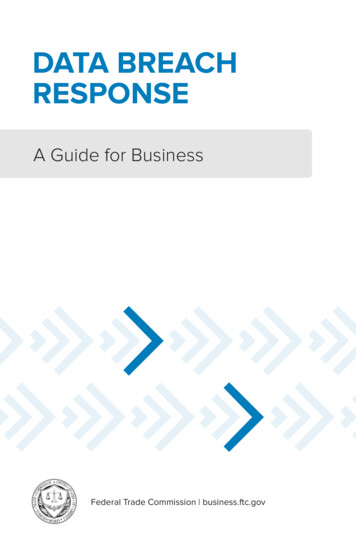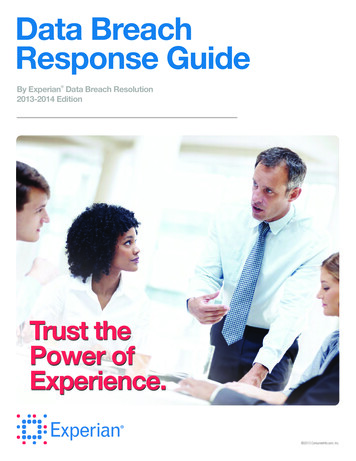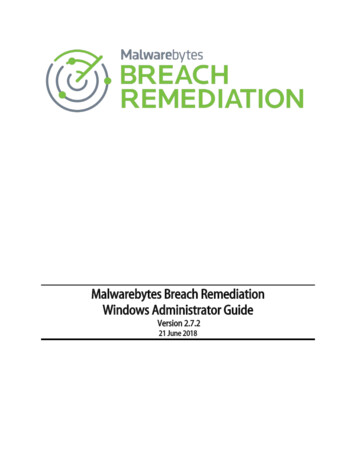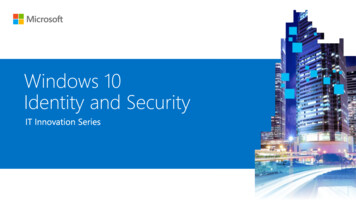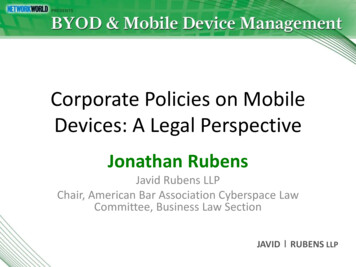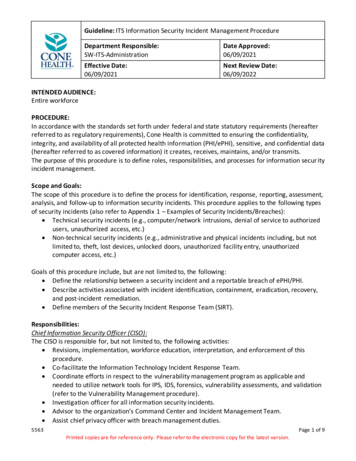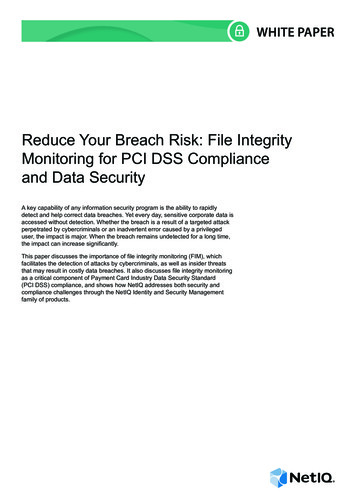
Transcription
WHITE PAPERReduce Your Breach Risk: File IntegrityMonitoring for PCI DSS Complianceand Data SecurityA key capability of any information security program is the ability to rapidlydetect and help correct data breaches. Yet every day, sensitive corporate data isaccessed without detection. Whether the breach is a result of a targeted attackperpetrated by cybercriminals or an inadvertent error caused by a privilegeduser, the impact is major. When the breach remains undetected for a long time,the impact can increase significantly.This paper discusses the importance of file integrity monitoring (FIM), whichfacilitates the detection of attacks by cybercriminals, as well as insider threatsthat may result in costly data breaches. It also discusses file integrity monitoringas a critical component of Payment Card Industry Data Security Standard(PCI DSS) compliance, and shows how NetIQ addresses both security andcompliance challenges through the NetIQ Identity and Security Managementfamily of products.
WHITE PAPERTable of ContentsIntroduction. 1File Integrity Monitoring: A Critical Piece in the Security Puzzle. 1A Closer Look at Insider Threat. 2Cyber Attacks for Profit. 2Catching the Cybercriminal . 2Combating the Threat: Inside and Out . 3A Case for Corporate Compliance: PCI DSS. 3Managing FIM for Security and Compliance: NetIQ Change Guardian. 4Working Together: NetIQ Identity and Security Management Solutions. 4Conclusion. 5About NetIQ. 5WHITE PAPER: Reduce Your Breach Risk: File Integrity Monitoring for PCI DSS Compliance and Data Security
IntroductionIf there were ever an era in which the saying “you can’t be too careful” rings true, it’s this one. Despite growingawareness and implementation of protective security measures, data breaches continue to dominate the headlines.The numbers are huge: 143 million records were compromised in 2009, capping off a six-year run in which a totalof over 900 million records were compromised.1 Even more alarming is the fact that these breaches happened rightunder the noses of information security teams, as evidenced by cases such as Heartland Payment Systems, where abreach of approximately 100 million credit card accounts went undetected for 18 months.2File Integrity Monitoring: A Critical Piece in the Security PuzzleFile integrity monitoring (FIM) has become a critical piece of the security puzzle, especially given the evolving natureof the threat to sensitive corporate data. Today, a new class of attacker has emerged: organized groups of criminaloperators that systematically and methodically gain access to systems and remain undetected over a prolongedduration, enabling them to achieve defined objectives, which typically extend beyond immediate financial gain. Thisscenario is referred to as an Advanced Persistent Threat (APT) and often manifests through breaches that leveragetrust relationships such as legitimate accounts to access and compromise targeted systems. Additional layers ofprotection, including FIM, are needed to protect sensitive corporate data against this type of threat.According to the 2010 Data Breach Investigations Report by Verizon Business, in cooperation with the United StatesSecret Service3, 48 percent of breaches involved insiders, a notable increase of 26 percent from 2008. In most cases,the evidence clearly pointed to elevated privileges being a precursor to the larger breaches. The scope of insiderthreat expands exponentially with the realization that once an attacker (such as one utilizing a malware infection) isin the system, it is almost impossible to distinguish him from an insider.According to the Verizon report, many of these cases follow a pattern in which an attacker hacks into the victim’snetwork (perhaps through stolen or weak credentials) and installs malware on systems to collect data. While the useof custom malware in attacks has remained stable, the malware itself has become increasingly difficult to detect,enabling it to successfully bypass standard anti-malware controls. Case in point, custom malware was utilizedsuccessfully in the Heartland breach as well as other major credit card breaches.Forrester Research4 notes that the best way to reduce the risk from this type of attack is to deploy file integritymonitoring tools that provide immediate alerts if unauthorized software is being installed or if critical files are modifiedor accessed by a privileged user.The deployment of FIM software is not only a best practice to help safeguard against security breaches, it is also arequirement of the Payment Card Industry Data Security Standard (PCI DSS.) Specifically, the PCI DSS standardcalls for the deployment of FIM software in order to alert personnel to unauthorized modification of critical system files,configuration files, or data. According to Verizon Business, over 79 percent of data breach victims surveyed in its 2010Data Breach Investigations Report were not compliant with PCI DSS.By detecting unauthorized access and unmanaged change to system files, FIM reduces the risk of: Data breaches – from insiders, privileged users, and attacks using malware.System instability – caused by unplanned or unauthorized changes to system configuration.Poor performance – often caused by changes outside of managed change control processes.Compliance failure – resulting from an inability to demonstrate due care and a lack of capability to monitoraccess to sensitive data.FIM is an important component of any effective information security program.1Verizon Business RISK Team in cooperation with the United States Secret Service, “2010 Data Breach Investigations Report,” Verizon Business,July 2010, p 2010-data-breach-report en xg.pdf?&src /worldwide/resources/index.xml&id .2John Kindervag, “PCI X-Ray: File Integrity Monitoring,” Forrester Research, Inc., October 26, 2009, http://www.forrester.com/rb/research.3Verizon Business RISK Team in cooperation with the United States Secret Service, “2010 Data Breach Investigations Report.”4John Kindervag, “PCI X-Ray: File Integrity Monitoring.”WHITE PAPER: Reduce Your Breach Risk: File Integrity Monitoring for PCI DSS Compliance and Data Security 1
A Closer Look at Insider ThreatAt the most basic level, there are two kinds of insider threats: malicious and non-malicious.Non-malicious threats include the exposure of critical systems or data through mistakes, poor judgment orunintentional acts. They may occur through the use of e-mail or other applications, and can be attributed to the loss ortheft of laptops and smartphones. As employee- and company-owned mobile devices increasingly enter the IT securitylandscape, existing security controls and defense strategies may not be adequate to cover exposure through thesevectors. As a result, non-malicious insider threats are becoming a growing concern.Malicious insiders, often motivated by financial gain or anger at their employer, can do significant damage over along period of time and can contribute to external breaches. Historical evidence has shown that the most damagingbreaches are caused by authorized users with elevated privileges who were not being monitored effectively, or byusers whose access privileges were not managed appropriately throughout the identity lifecycle. In the most recentVerizon Risk report, 24 percent of insider attacks were perpetrated by employees who recently underwent some kindof job change.Cyber Attacks for ProfitSeveral of the most financially significant security breaches of the past decade have been the result of targeted,custom attacks perpetrated by sophisticated hackers. The breach of Heartland Payment Systems stands as one of themost infamous examples of such an attack. A breach of immense magnitude, security experts estimate that 100 millioncredit cards issued by 650 financial services companies may have been compromised. With a 300 million loss inmarket capitalization and over 30 million in direct losses, the financial impact to Heartland has been earth-shattering.5The Stuxnet Worm is another good example of a sophisticated multi-vector attack. According to Bruce Schneier6,the Stuxnet Worm “is a ‘groundbreaking’ piece of malware so devious in its use of unpatched vulnerabilities, sosophisticated in its multipronged approach, that the security researchers who tore it apart believe it may be the workof state-backed professionals.” To date, the program appears to have wiped out roughly a fifth of Iran’s nuclearcentrifuges helping to delay, though not destroy, the country’s ability to make its first nuclear arms.7 Designed toinfiltrate industrial control systems, experts warn that it could be used as a blueprint to sabotage machines that arecritical to power plants, electrical grids and other infrastructure.Catching the CybercriminalOne of the greatest changes in attacker techniques is the high degree of stealth exhibited in the more sophisticatedattacks. This enables the breach to go undetected for a prolonged period of time – during which targeted systems areexploited. For example, in the case of Heartland Payment System, the breach went undetected for 18 months. Eventhen, it was not discovered by Heartland’s internal security team, but by third parties.These sophisticated attacks take a variety of forms and use multiple attack vectors. However, a typical onlinefraud attack will exhibit several shared steps and characteristics. In its 2010 Data Breach Investigations Report,Verizon Business found that in just under half of their cases in 2009, there was at least some indication of pre-attackreconnaissance, most often in the form of system foot printing, scanning, and enumeration. Once the perimeter of thevictim organization was breached, almost 40 percent of hackers were able to compromise the system in a matter ofminutes or hours.5John Kindervag, “PCI X-Ray: File Integrity Monitoring.”6Bruce Schneier, “Schneier on Security: The Stuxnet /09/the stuxnet wor.html (accessed February 10, 2011).7William J. Broad, John Markoff, & David E. Sanger, Israeli Test on Worm Called Crucial in Iran Nuclear Delay,New York Times, January 15, 2011, /16stuxnet.html (accessed February 10, 2011).WHITE PAPER: Reduce Your Breach Risk: File Integrity Monitoring for PCI DSS Compliance and Data Security 2
Brand Damage /Litigation / FinesDetection andRemediationData BreachOccursBreach of DefensesReconnaissanceAccording to the Verizon report, in about 68 percent of cases, it took organizations weeks and even months to discoverthe breaches. If the breach is detected at all, it is usually through back-end monitoring by credit card companiesthrough a technique known as Common Point of Purchase (CPP), which is typically used to triangulate fraud.Sensitive Information StolenWeeksHoursMonthsWeeksYearsFigure 1. Timeline of a Typical Data BreachCombating the Threat: Inside and OutThe sharp increase from last year’s figures ( 26 percent) for breaches involving insiders may lead one to wonder ifthere is an epidemic of insider attacks. Regardless of the source of this growth, there are simple strategies that can beimplemented to ensure that sensitive corporate data is protected. From the Verizon report, we learned that employeesare often granted more privileges than they need to perform their job duties and privileged-user activity is oftennot monitored adequately. The simple solution is to monitor privileged users in real time to identify unauthorized orunusual activity. Because privileged users are often given access to sensitive or critical system and data files, the useof FIM technology can help track access and changes to critical system files, security log files, sensitive data files, orshares. In the case of system files on business-critical systems or sensitive data files, real-time alerts for changes canbe set, enabling the immediate recognition of a problem.Remember that once an attacker gains access to an internal user account, their behavior can be indistinguishablefrom legitimate activity. The use of FIM can detect the modification of files associated with an APT. This activity couldthen be investigated immediately, before a more costly breach can occur. Early detection of such a threat wouldenable a security team to significantly cut the response time and contain any damages incurred.A Case for Corporate Compliance: PCI DSSIn addition to helping reduce the risk of data breach, compliance is another reason for file integrity monitoring. ThePayment Card Industry Data Security Standard is a contractual requirement for businesses that handle cardholderinformation for Visa, MasterCard, Discover, American Express, and Diner’s Club.8 PCI DSS specifies FIM inrequirements 10 and 11.Requirement 10.5. Ensure audit trails (log files) are secure“Use file-integrity monitoring or change-detection software on logs to ensure that existing log data cannotbe changed without generating alerts (although new data being added should not cause an alert.)”By mandating file integrity monitoring or change-detection software on logs, and specifying that any changes must beaccompanied by an alert, PCI DSS Requirement 10.5 helps ensure audit trails remain secure.Requirement 11.5. Access and changes to critical content and system filesPCI Security Standards Council, LLC, “About the PCI Data Security Standard (PCI ity standards/pci dss.shtml (accessed March 29, 2010).8WHITE PAPER: Reduce Your Breach Risk: File Integrity Monitoring for PCI DSS Compliance and Data Security 3
“Deploy file-integrity monitoring software to alert personnel to unauthorized modification of critical system files,configuration files, or content files; and configure the software to perform critical file comparisons at least weekly.”The intent of PCI DSS Requirement 11.5 is to give companies a solid defense against the exploitation of criticalresources, especially servers. For companies to ensure the protection of critical systems, they must know about andbe able to document changes to files and file systems, including: Who made the changeWhat exactly was changed: files, registry, or configuration settingsWhen it was changedWhat the value was before the changeWhat the value was after the changeIf this change was authorized as part of the change management processManaging FIM for Security and Compliance: NetIQ Change GuardianThe threat landscape that security professionals face today is complex. Whether the concern is a crippling malwareattack or unauthorized access to sensitive data by an insider, the risk to critical data and infrastructure can besignificantly reduced through the real-time detection of access and changes to sensitive files and systems that isprovided by a FIM solution.In addition to taking vital steps to protect their sensitive data, corporations that implement FIM also ensure that theymeet the requirements of compliance mandates, which specifically call out file integrity monitoring solutions – thusavoiding costly fines and other negative effects of non-compliance.The NetIQ Change Guardian family of products encompasses a real-time file integrity monitoring approach that: Provides real-time detection of changes to critical systems and files. Enables alerting even if the content was simply viewed and not changed. Integrates that alerting into leading Security Information and Events Management (SIEM) solutions such asNetIQ Security ManagerTM. Ensures the alerting process provides rich information, such as when the change was made, who made thechange, what was changed, and what the state was before the change. Helps achieve compliance by demonstrating the capability to monitor access to sensitive data. Detects changes on your most important platforms: Microsoft Windows, Active Directory (including Group Policyobjects), UNIX and Linux.The NetIQ Change Guardian family of products provides real-time detection of unmanaged changes to critical files,system configurations, and Active Directory (including Group Policy objects), to ensure your security teams canproactively protect sensitive corporate information and customer data both from malicious attacks and accidentaldamage. These solutions provide the information necessary to rapidly make intelligent decisions, limit the risk ofcorporate data loss, and maximize the return on your existing security investments.Working Together: NetIQ Identity and Security Management SolutionsUnmanaged change to the configuration of critical systems and infrastructure represents a significant and growing riskto the security of organizational data, customer information, and system stability. NetIQ Change Guardian enhancesyour ability to detect any unmanaged changes and respond efficiently to vastly reduce the risk of malicious activity andto support comprehensive data protection.NetIQ provides an integrated solution that enables security teams to build a more complete security and complianceinfrastructure that is scalable and reduces workload. NetIQ Change Guardian works in conjunction with best-inclass workflow automation tools and with NetIQ Directory and Resource Administrator TM for granular control ofadministrative access, to form a powerful, integrated, automated solution for identity and security management. NetIQChange Guardian also integrates tightly with SIEM solutions such as the award-winning NetIQ Security Manager inorder to present correlated, rich, and relevant information in real time to security and compliance teams. Together,these products help companies not only protect their data, but also comply with important regulatory mandates suchas those in PCI DSS.WHITE PAPER: Reduce Your Breach Risk: File Integrity Monitoring for PCI DSS Compliance and Data Security 4
ConclusionBecause of its ability to rapidly detect unauthorized access to critical systems, FIM is fundamental in the preventionof data breaches that occur due to custom malware attacks and malicious (or non-malicious) insider activities. FIM isalso an important component of PCI DSS compliance, specifically referenced in Requirements 10.5 and 11.5 to helpensure that access and changes to critical systems are known about and securely documented. In order to effectivelymaintain both security and compliance, FIM software should also be integrated with SIEM solutions to providecorrelation with other security events and ensure that critical data and systems stay secure.The NetIQ Change Guardian family of products provides you with real-time detection and alerting for changes to filesand system configurations for critical hosts. In addition to reducing the risk of data breaches and insider attacks, itprovides the “who, what, when and how” for changes to other essential components within your infrastructure, such asActive Directory and Group Policy objects.Leveraged in conjunction with traditional SIEM solutions, this family of products provides a powerful and effective wayto reduce time spent gathering information, accelerate decision making, and reduce the risk of breaches.For more information on how to address your requirements for file integrity monitoring, visit www.netiq.com or call yourlocal NetIQ representative or partner.About NetIQNetIQ is a global, IT enterprise software company with relentless focus on customer success. Customers and partnerschoose NetIQ to cost-effectively tackle information protection challenges and manage the complexity of dynamic,highly-distributed business applications.Our portfolio includes scalable, automated solutions for Identity, Security and Governance, and IT OperationsManagement that help organizations securely deliver, measure, and manage computing services across physical,virtual, and cloud computing environments. These solutions and our practical, customer-focused approach to solvingpersistent IT challenges ensure organizations are able to reduce cost, complexity and risk.To learn more about our industry-acclaimed software solutions, visit www.netiq.com.This document could include technical inaccuracies or typographical errors. Changes are periodically made to the information herein. These changes may be incorporated in new editions of thisdocument. NetIQ Corporation may make improvements in or changes to the software described in this document at any time.Copyright 2012 NetIQ Corporation and its affiliates. All Rights Reserved.ActiveAudit, ActiveView, Aegis, AppManager, Change Administrator, Change Guardian, Compliance Suite, the cube logo design, Directory and Resource Administrator, Directory SecurityAdministrator, Domain Migration Administrator, Exchange Administrator, File Security Administrator, Group Policy Administrator, Group Policy Guardian, Group Policy Suite, IntelliPolicy, KnowledgeScripts, NetConnect, NetIQ, the NetIQ logo, PSAudit, PSDetect, PSPasswordManager, PSSecure, Secure Configuration Manager, Security Administration Suite, Security Manager, ServerConsolidator, VigilEnt, and Vivinet are trademarks or registered trademarks of NetIQ Corporation or its subsidiaries in the USA. All other company and product names mentioned are used only foridentification purposes and may be trademarks or registered trademarks of their respective companies.Worldwide HeadquartersFor a complete list of our offices1233 West Loop South, Suite 810Houston, Texas 77027 USAWorldwide: 713.548.1700In North America, Europe, the Middle EastAfrica, Asia-Pacific and Latin America,please visit www.netiq.com/contacts.U.S. / Canada Toll Free: unity.netiq.comWHITE PAPER: Reduce Your Breach Risk: File Integrity Monitoring for PCI DSS Compliance and Data Security 5
WHITE PAPER: Reduce Your Breach Risk: File Integrity Monitoring for PCI DSS Compliance and Data Security 2 A Closer Look at Insider Threat At the most basic level, there are two kinds of insider threats: malicious and non-malicious. Non-malicious threats include the exposure of critical systems or data through mistakes, poor judgment or
